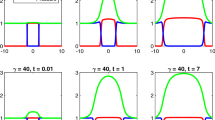Abstract
In this paper, we address some modelling issues related to biological growth. Our treatment is based on a formulation for growth that was proposed within the context of mixture theory (J Mech Phys Solids 52:1595–1625, 2004). We aim to make this treatment more appropriate for the physics of porous soft tissues, paying particular attention to the nature of fluid transport, and mechanics of fluid and solid phases. The interactions between transport and mechanics have significant implications for growth and swelling. We also reformulate the governing differential equations for reaction-transport of solutes to represent the incompressibility constraint on the fluid phase of the tissue. This revision enables a straightforward implementation of numerical stabilisation for the advection-dominated limit of these equations. A finite element implementation with operator splitting is used to solve the coupled, non-linear partial differential equations that arise from the theory. We carry out a numerical and analytic study of the convergence of the operator splitting scheme subject to strain- and stress-homogenisation of the mechanics of fluid–solid interactions. A few computations are presented to demonstrate aspects of the physical mechanisms, and the numerical performance of the formulation.
Similar content being viewed by others
References
Alberts B, Johnson A, Lewis J, Raff M, Roberts K, Walter P (2002) Molecular biology of the cell. Garland Science, Oxford
Ambrosi D, Mollica F (2002) On the mechanics of a growing tumor. Int J Eng Sci 40: 1297–1316
Armero F (1999) Formulation and finite element implementation of a multiplicative model of coupled poro-pplasticity at finite strains under fully-saturated conditions. Comp Methods Appl Mech Eng 171: 205–241
Bischoff JE, Arruda EM, Grosh K (2002a) A microstructurally based orthotropic hyperelastic constitutive law. J Appl Mech 69: 570–579
Bischoff JE, Arruda EM, Grosh K (2002b) Orthotropic elasticity in terms of an arbitrary molecular chain model. J Appl Mech 69: 198–201
Brennen CE (1995) Cavitation and bubble dynamics. Oxford University Press, New York
Bromberg S, Dill KA (2002) Molecular driving forces: statistical thermodynamics in chemistry and biology. Garland, Oxford
Brooks A, Hughes T (1982) Streamline upwind/Petrov–Galerkin formulations for convection dominated flows with particular emphasis on the incompressible Navier–Stokes equations. Comp Methods Appl Mech Eng 32: 199–259
Calve S, Dennis R, Kosnik P, Baar K, Grosh K, Arruda E (2004) Engineering of functional tendon. Tissue Eng 10: 755–761
Cowin SC, Hegedus DH (1976) Bone remodeling I: a theory of adaptive elasticity. J Elast 6: 313–325
Epstein M, Maugin GA (2000) Thermomechanics of volumetric growth in uniform bodies. Int J Plast 16: 951–978
Fung YC (1993) Biomechanics: mechanical properties of living tissues, 2nd edn. Springer, New York
Garikipati K, Rao VS (2001) Recent advances in models for thermal oxidation of silicon. J Comput Phys 174: 138–170
Garikipati K, Arruda EM, Grosh K, Narayanan H, Calve S (2004) A continuum treatment of growth in biological tissue: mass transport coupled with mechanics. J Mech Phys Solids 52: 1595–1625
Garikipati K, Olberding JE, Narayanan H, Arruda EM, Grosh K, Calve S (2006) Biological remodelling: stationary energy, configurational change, internal variables and dissipation. J Mech Phys Solids 57: 1493–1515
Han S, Gemmell SJ, Helmer KG, Grigg P, Wellen JW, Hoffman AH, Sotak CH (2000) Changes in ADC caused by tensile loading of rabbit achilles tendon: evidence for water transport. J Magn Reson 144: 217–227
Hughes T, Franca L, Mallet M (1987) A new finite element formulation for computational fluid dynamics: VII. Convergence analysis of the generalized SUPG formulation for linear time-dependent multidimensional advective–diffusive systems. Comp Methods Appl Mech Eng 63(1): 97–112
Humphrey JD, Rajagopal (2002) A constrained mixture model for growth and remodeling of soft tissues. Math Methods Mod Appl Sci 12(3): 407–430
Klisch SM, van Dyke TJ, Hoger A (2001) A theory of volumetric growth for compressible elastic biological materials. Math Mech Solids 6: 551–575
Kratky O, Porod G (1949) Röntgenuntersuchungen gelöster Fadenmoleküle. Recl Trav Chim 68: 1106–1122
Kuhl E, Garikipati K, Arruda E, Grosh K (2005) Remodeling of biological tissue: mechanically induced reorientation of a transversely isotropic chain network. J Mech Phys Solids (UK) 53(7): 1552–1573
Lee EH (1969) Elastic–plastic deformation at finite strains. J Appl Mech 36: 1–6
Milton GW (2002) Theory of composites. Cambridge University Press, London
Nordin M, Lorenz T, Campello M (2001) Biomechanics of tendons and ligaments. In: Nordin M, Frankel VH (eds) Basic biomechanics of the musculoskeletal system. Lippincott Williams and Wilkins, New York, pp 102–125
Rao VS, Hughes TJR, Garikipati K (2000) On modelling thermal oxidation of silicon ii: Numerical aspects. Int J Numer Methods Eng 47(1/3): 359–378
Rodriguez EK, Hoger A, McCullough AD (1994) Stress-dependent finite growth in soft elastic tissues. J Biomech 27: 455–467
Sengers BG, Oomens CWJ, Baaijens FPT (2004) An integrated finite-element approach to mechanics, transport and biosynthesis in tissue engineering. J BioMech Eng 126: 82–91
Simo JC, Taylor RL, Pister KS (1985) Variational and projection methods for the volume constraint in finite deformation elasto-plasticity. Comp Methods Appl Mech Eng 51: 177–208
Taber LA, Humphrey JD (2001) Stress-modulated growth, residual stress and vascular heterogeneity. J BioMech Eng 123: 528–535
Taylor RL (1999) FEAP—a finite element analysis program. University of California at Berkeley, Berkeley
Tezduyar T, Sathe S (2003) Stabilization parameters in SUPG and PSPG formulations. J Comput Appl Mech 4: 71–88
Truesdell C, Noll W (1965) The non-linear field theories (Handbuch der Physik, band III). Springer, Berlin
Author information
Authors and Affiliations
Corresponding author
Rights and permissions
About this article
Cite this article
Narayanan, H., Arruda, E.M., Grosh, K. et al. The micromechanics of fluid–solid interactions during growth in porous soft biological tissue. Biomech Model Mechanobiol 8, 167–181 (2009). https://doi.org/10.1007/s10237-008-0126-1
Received:
Accepted:
Published:
Issue Date:
DOI: https://doi.org/10.1007/s10237-008-0126-1




